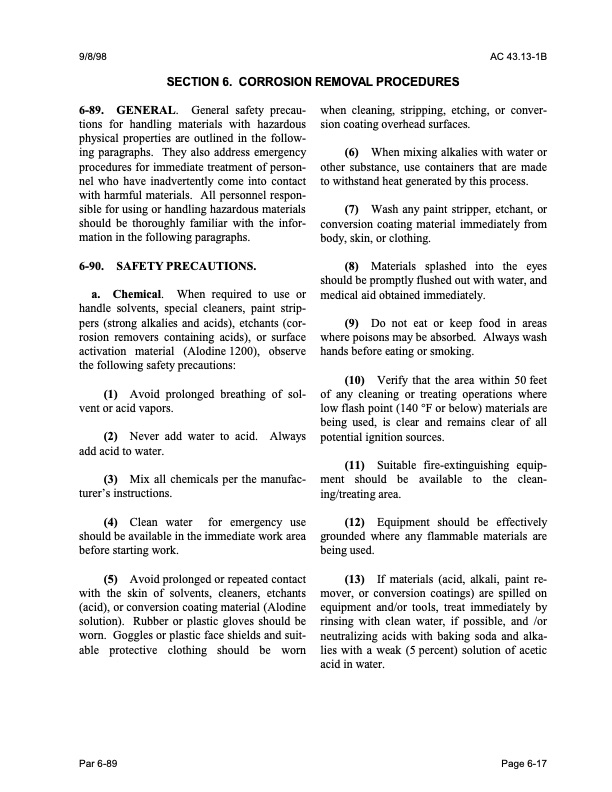
PDF Publication Title:
Text from PDF Page: 288
9/8/98 AC 43.13-1B SECTION 6. CORROSION REMOVAL PROCEDURES 6-89. GENERAL. General safety precau tions for handling materials with hazardous physical properties are outlined in the follow ing paragraphs. They also address emergency procedures for immediate treatment of person nel who have inadvertently come into contact with harmful materials. All personnel respon sible for using or handling hazardous materials should be thoroughly familiar with the infor mation in the following paragraphs. 6-90. SAFETY PRECAUTIONS. a. Chemical. When required to use or handle solvents, special cleaners, paint strip pers (strong alkalies and acids), etchants (cor rosion removers containing acids), or surface activation material (Alodine 1200), observe the following safety precautions: (1) Avoid prolonged breathing of sol vent or acid vapors. (2) Never add water to acid. Always add acid to water. (3) Mix all chemicals per the manufac turer’s instructions. (4) Clean water for emergency use should be available in the immediate work area before starting work. (5) Avoid prolonged or repeated contact with the skin of solvents, cleaners, etchants (acid), or conversion coating material (Alodine solution). Rubber or plastic gloves should be worn. Goggles or plastic face shields and suit able protective clothing should be worn when cleaning, stripping, etching, or conver sion coating overhead surfaces. (6) When mixing alkalies with water or other substance, use containers that are made to withstand heat generated by this process. (7) Wash any paint stripper, etchant, or conversion coating material immediately from body, skin, or clothing. (8) Materials splashed into the eyes should be promptly flushed out with water, and medical aid obtained immediately. (9) Do not eat or keep food in areas where poisons may be absorbed. Always wash hands before eating or smoking. (10) Verify that the area within 50 feet of any cleaning or treating operations where low flash point (140 °F or below) materials are being used, is clear and remains clear of all potential ignition sources. (11) Suitable fire-extinguishing equip ment should be available to the clean ing/treating area. (12) Equipment should be effectively grounded where any flammable materials are being used. (13) If materials (acid, alkali, paint re mover, or conversion coatings) are spilled on equipment and/or tools, treat immediately by rinsing with clean water, if possible, and /or neutralizing acids with baking soda and alka lies with a weak (5 percent) solution of acetic acid in water. Par 6-89 Page 6-17PDF Image | AFS-640

PDF Search Title:
AFS-640Original File Name Searched:
ac_43.13-1b_w-chg1.pdfDIY PDF Search: Google It | Yahoo | Bing
5,000 BF Shipping Container Lumber Dry Kiln For Quality Lumber The 5,000 BF container kiln consists of one 40 foot high-cube aluminum shipping container... More Info
Shipping Container Lumber Dry Kilns by Global Energy Global Energy designed and developed the container kiln back in 1991. The purpose is to give access to portable sawmill owners, furniture makers, and small business the value added profit of dry kiln lumber and quality hardwoods... More Info
Vacuum Kiln Conversion Kit for Lumber and Wood Dry Kilns Convert your existing conventional dry kiln into a fast drying vacuum kiln. Similar to vacuum bagging in the boat building and aircraft industry, we have come up with a proprietary process which allows you to build a very simple vacuum kiln at a fraction of the price, and without the intensive conventional metal chamber structure... More Info
Vacuum Pump Cart System for Bagging Clamping Wood Drying and more Vacuum Cart with 2HP Pump and Dual Pistons with multiple multiplex vacuum ports and liquid reservoir... More Info
Vacuum Bagging Basics Vacuum bagging is a method of clamping, which has traditionally been used in the composites industry, but can also be used for vacuum drying materials, including wood products... More Info
| CONTACT TEL: 608-238-6001 Email: greg@globalmicroturbine.com | RSS | AMP |